
ICCROM_ICS11_History_en
.pdf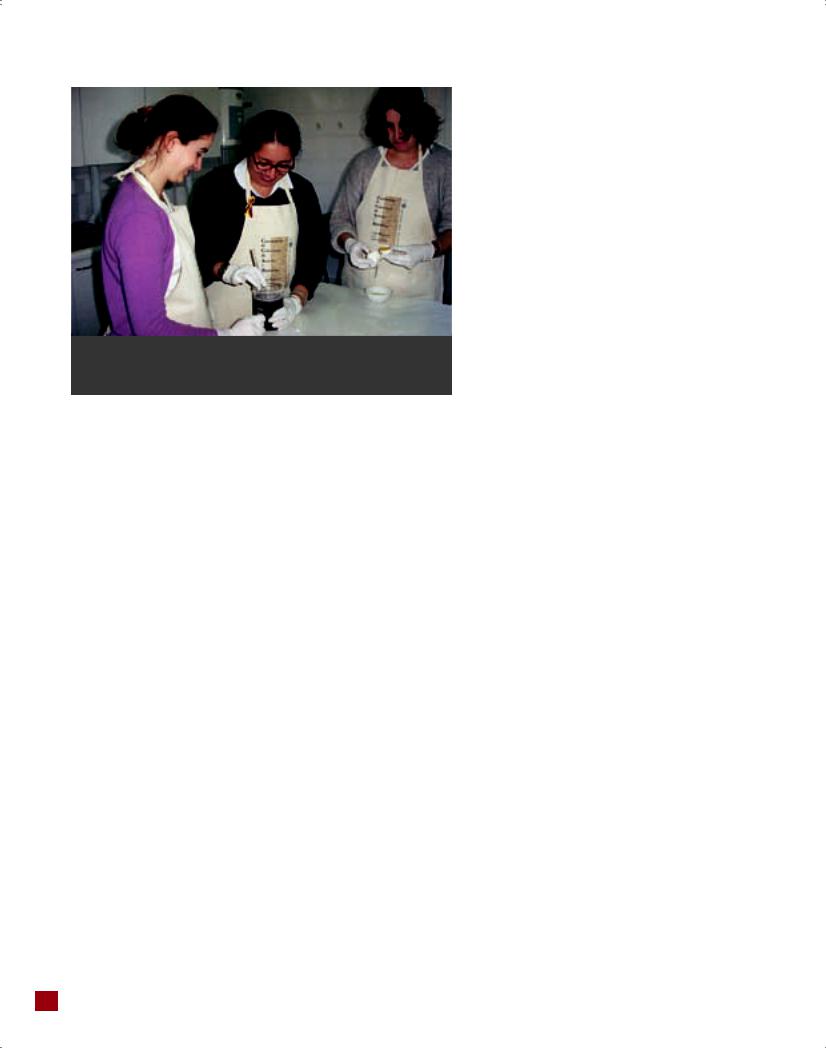
Figure 6 37
Workshop on the management of archives, Chile, 2001
The course addressed conservator-restorers, curators and conservation scientists, and its purpose was to increase interdisciplinary collaboration among professionals in the decision-making process. As a participant commented after the course: “The course helps to change the way you think ... the courage to make decisions, to understand and justify them, and to document them.”295 This programme was accompanied by other initiatives related to improving conservation education.
Building on its past collaboration with Japanese conservation institutions, ICCROM launched new projects for the biennium 2004-05 under the slogan, East meets West - Japanese and Western conservation traditions. The ninth three-week course on the Conservation of Japanese Paper took place in Tokyo and Kyoto in September-October 2004, organized by the National Research Institute for Cultural Properties of Tokyo and ICCROM. In the following year, the Research Institute published a bilingual compendium of all course materials. In October 2005, the Fourth International Course on Conservation of Urushi (Lacquer) took place in Tokyo and Kiso, with participants from the USA and several European countries.
In collaboration with the National Archives of Brazil and the Centre for the Conservation and Preservation of Photographs of Funarte (National Foundation of Arts), ICCROM organized a course on Science in the Conservation of Archival Collections, held in English in Rio de Janeiro in July 2005. The intensive three-week course, the first of its kind, explored a variety of aspects relevant to planning and implementing timely, cost-efficient and methodologically sound research within the context of
archival institutions. Special attention was paid to effectively adapting and applying results of research carried out by colleague institutions and non-heritage disciplines.
Evaluation of course programmes
The Architectural Conservation (ARC) Programme was re-configured as a series of new activities, addressing strategically issues to improve the conservation of the built heritage, acting as an observatory on related matters, and serving as an advanced forum for reflection on future programmes. In response to perceived priorities, ICCROM organized a series of international courses on Architectural Records, Inventories, Information Systems and Conservation (ARIS), the first one held at ICCROM in Rome in late 2003. Several other regularly held technical courses were all grouped within the ARC programme such as the biennial International Course on Wood Conservation Technology in Oslo, organized in 2002, 2004 and 2006, when the responsibility and funding of the course were gradually transferred to the Norwegian partners.86 Other examples included the Course on Conservation and Restoration of Wooden Structures in the Asia-Pacific Region in Japan, organized jointly with UNESCO and Japanese authorities;87 and the International Course on Conservation of Modern Architecture (MARC) that took place in Jyväskylä, Finland, in 2002, 2004 and 2006, in collaboration with the Alvar Aalto Academy, the Royal University College of Fine Arts in Stockholm, Alvar Aalto Museum and the Finnish National Board of Antiquities. The TERRA Project developed in partnership with CRATerre-EAG and the Getty Conservation Institute, giving particular attention to the Latin American region as expressed in an International Seminar on Earthen Architecture in seismic-hazard areas, “Sismo Adobe 2005”, organized in Lima, Peru in May 2005. The project included various activities for the development of educational and training tools related to earthen architectural heritage. ICCROM also participated in a number of meetings held in consequence of the earthquake in Bam in December 2003.
In 2002-03, following a Council decision, an evaluation of the Architectural Conservation programme and of the Venice Stone Conservation Course was undertaken by an external firm (Minerva Partners of New York, who had already carried out a preliminary evaluation of the ARC course in 2001). The report noted positively the efforts of ICCROM over the years to develop international interdisciplinary training programmes. With regard to the Stone Course, the report questioned to what extent an interdisciplinary course focused on decision-making processes in stone conservation could satisfy all partic-
 130
130 ICCROM and the Conservation of Cultural Heritage. A history of the Organization’s first 50 years, 1959-2009
ICCROM and the Conservation of Cultural Heritage. A history of the Organization’s first 50 years, 1959-2009
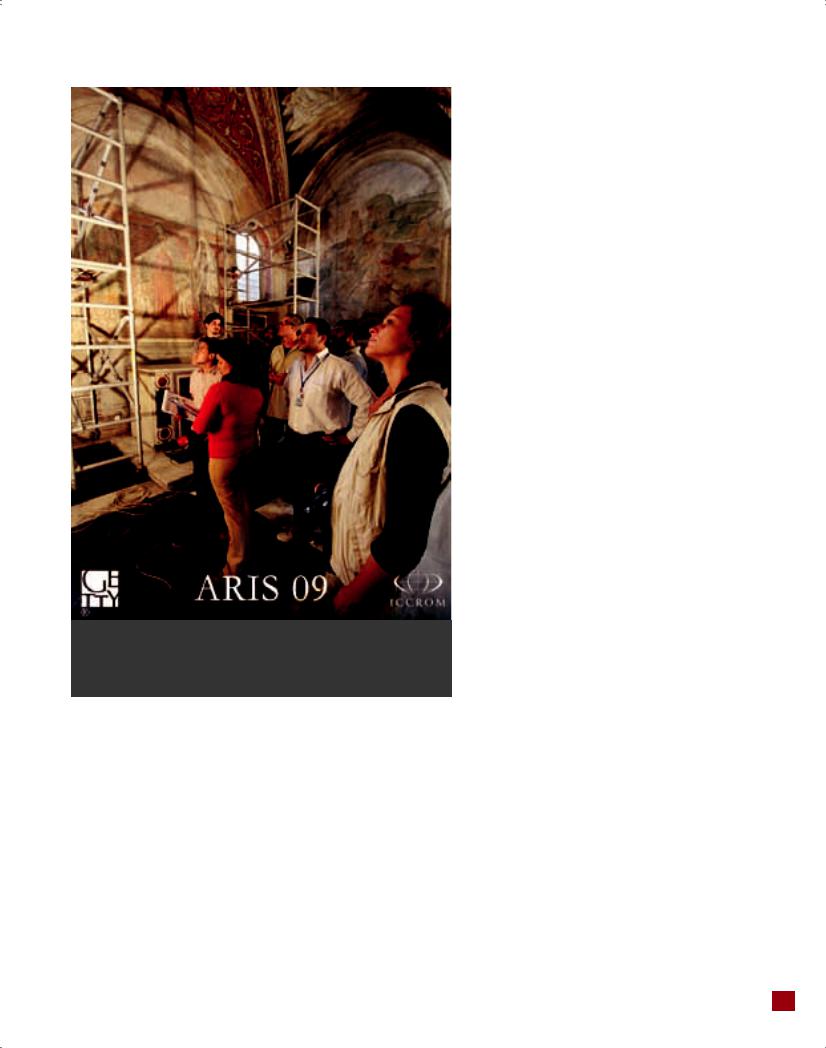
Figure 6 38
Poster for the course on architectural recording and information systems, ARIS 2009, organized in Rome jointly by ICCROM and the Getty Conservation Institute
ipants. To what extent could such a course organized in one place cover all the problems involved, particularly taking into account the important advances in this field since the course was first inaugurated? 298
At its 67th meeting on 17 November 2003, the Council reviewed the results of the new evaluation reports with the opinion that the “Council Members agreed that the reviews of the Architectural Conservation (ARC) Programme and Venice Stone Course were of such poor quality that no decisions could be based on them alone, especially without firm recommendations from ICCROM staff. Resolution of the problem was again deferred and sent for consideration to the Council for the biennium 2003-2005.”299 Subsequently the Council appointed a Working Group to
examine the situation and make recommendations with as co-chairmen John Fidler and Blaine Cliver. The Fidler Report noted that there had obviously been a mistake in the choice of the contractor but continued: “The contractors made poor interpretation of invalid statistics; placed mistaken emphasis on past ICCROM trainees and their perceptions where no comparisons were available; failed to make sufficient rapport with ICCROM’s expert trainers; and made no attempt to evaluate current international training needs against a backdrop of changing quality in regional conservation training.”300 The report further noted that Minerva had failed to see the Stone Course and the ARC Course in their context, which included for example the courses on the Conservation of Wall Paintings and Architectural Surfaces and on Scientific Principles of Conservation, which ran parallel to ARC. The ARC programme had continuously changed over time, and had focused on very specific and different audiences at any one time: “Over its 32 years, the ARC course did, as Minerva states, advance the state of knowledge and quality of practice in the architectural conservation field. Many of its seminal published outputs started life as course handouts, or as proceedings from colloquium designed to establish the state-of-the-art for teaching purposes. But to suppose that this did not happen at a scale congruent with ICCROM’s mission, responsibility and opportunities as a leading international institution ignores the reality of the scale of architectural conservation practice worldwide. ICCROM’s ambitions ought to be based on what is practical at a strategic level.”301 Fidler also notes that for many participants the ARC course had been the only exposure to international conservation practice; therefore, it was important to retain its broad panorama.
Regarding the Venice Stone Conservation Course, Minerva reported that in the five cycles since 1993, the course had trained nearly 100 conservators, the majority of whom now occupied positions of influence within major national conservation agencies in the world. It also noted that the teaching faculty included internationally recognized stone conservation and research expertise. At the same time, it was clear that a relatively short course could not include all aspects (structural and material), but was focused on surface treatments. Minerva had assumed that because there were several courses around the world teaching stone conservation, these would all be of the same calibre and effectiveness. The Fidler Report noted: “This is not the case – for example, not one of the specialist stone conservation units within postgraduate architectural conservation courses at British universities are of the calibre or duration of the Venice Stone Course. Nor are these national and regional courses
6 New global challenges (1988-2005)  131
131
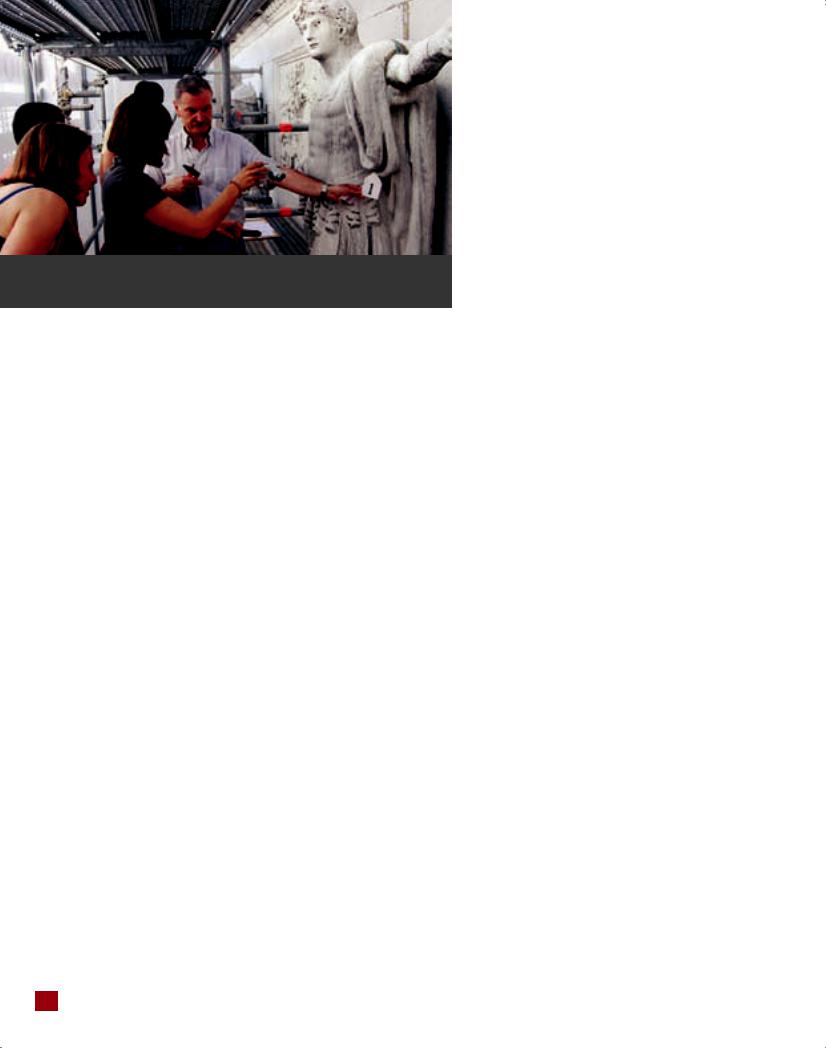
Figure 6 39
Stone course in Venice; Lorenzo Lazzarini teaching
always available to ICCROM’s constituency because of the lack of accessibility (i.e. language, transport and costs) and time components involved (i.e. the length of postgraduate degree courses).”302 One of the criticisms brought up by Minerva was that, in the 1990s, the Council had thought that Rome and Venice did not constitute good didactic tools especially for those based in rural developing countries. The Fidler report instead argued that this perception denied ICCROM’s extensive infrastructure and resources in Rome. It stated that “by bringing trainees away from their own environments and exposing them to new experiences and peers from other cultures in the Rome-based ARC and Venice-based Stone courses, all participants benefited from cross-cultural and technical understanding. The vernacular architecture and materials of their homelands could be shown through publications, slide shows and seminar meetings and discussed with others whose experiences were similar but different.”303 The Working Group report concluded that ICCROM’s own paper on Conservation of the Built Heritage: a long-term ICCROM Programme - discussion document (February 2004) was helpful and was seen to converge on points of strategy and detail.
The Africa 2009 programme that had been established at a regional meeting of African heritage professionals in Abidjan in 1998 was organized in close collaboration with the UNESCO World Heritage Centre and CRATerre-EAG. The long-term aim of the AFRICA 2009 programme was to improve the conditions for the conservation of immovable cultural heritage in Sub-Saharan Africa integrating it into a sustainable development processes. It aimed to create better policies and legal frameworks for conservation, to increase professional capacity, and to create better networks of communication. The programme was a sort of sister programme to PREMA.304 The programme included a series of regional courses in the conservation and management of immovable
cultural heritage, organized in several African countries. These were complemented by seminars for conservation directors, short-term technical courses, regional thematic seminars, research on management planning, a survey of training institutions in SubSaharan Africa, legal and administrative frameworks and documentation of dry-stone constructions. The programme generated the development of a crosscontinent network of contacts and promotion of exchange. It also produced a number of publications of conference papers as well as research on African themes. In an evaluation report in 2002, Africa 2009 was considered to have met the basic requirements for training as means of capacity-building, and the report recommended that the programme be granted full support for continuation though with some adjustments. It was recommended to continue more detailed surveys on impacts and needs assessment in the region, increase the number of courses, and continue working on a network for the exchange of information. It was hoped that the staff involved in the project could be increased, and that the project could be gradually institutionalized.305
The Support Programme for the Cultural Heritage of North Africa and Near and Middle East Countries (NAMEC) set out to improve the conservation and enhancement of the material cultural heritage in the Maghreb countries by improving the human resources involved. The programme was received favourably by the Ministry of Foreign Affairs of Italy, because its objectives coincided with the general political objectives to improve employment opportunities in North Africa, thus reducing the pressure for emigration. In 2002 the NAMEC programme was evaluated externally.306 The evaluation report recognized that particularly the Tunis Architectural Conservation Course “appeared to be wholly relevant, because it fulfilled an important function for the provision of training regarding the immovable cultural heritage in the country itself and in the region as a whole.”307 Regarding the conservation of movable heritage, the issues were more complex, considering that “the institutions in these countries, except for Tunisia, are still only just beginning to lay down a clear-cut strategy for human resource management. This being so, trying to create the profile of a ‘conservation manager’, with a multidisciplinary academic background was relevant, particularly because this type of course is unique in the Maghreb countries and fills a training void. However, the courses and the planning of these courses could have been ‘more relevant’ if the profiles set out and the resultant objectives had been defined on the basis of conservation policies and the human resource training and management strategies resulting from them.”308
 132
132 ICCROM and the Conservation of Cultural Heritage. A history of the Organization’s first 50 years, 1959-2009
ICCROM and the Conservation of Cultural Heritage. A history of the Organization’s first 50 years, 1959-2009
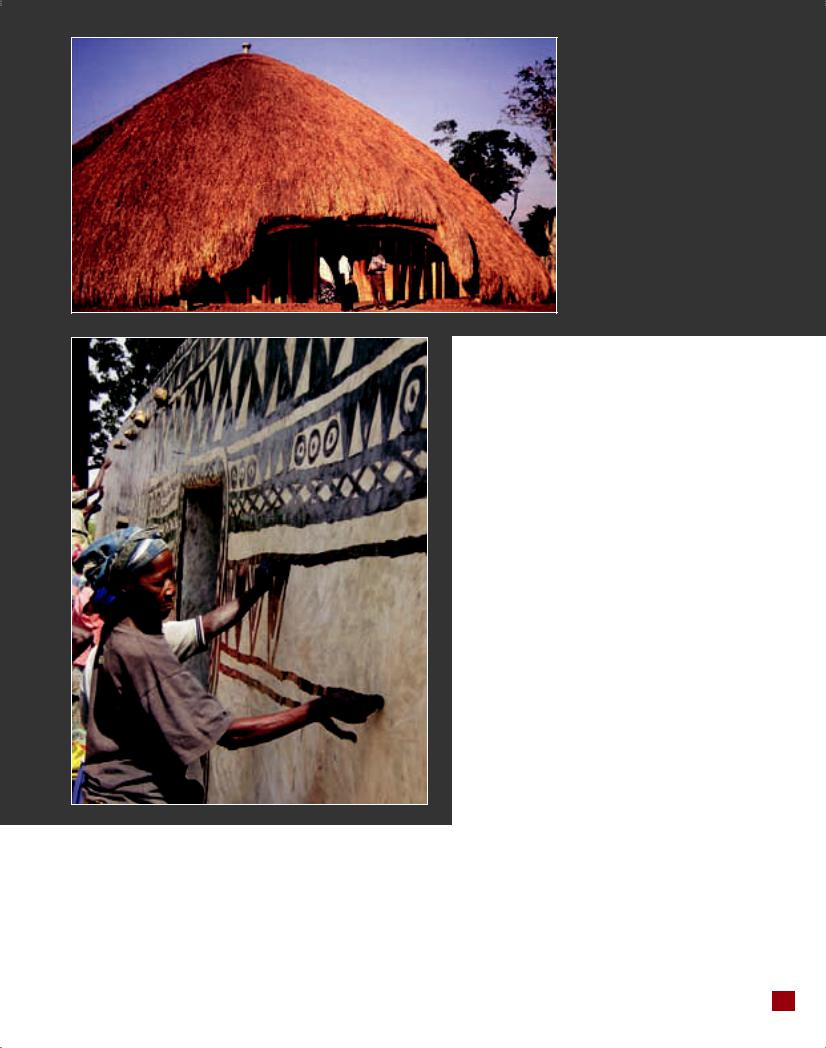
The report noted that the level of impact of the Maghreb courses had been very significant in Tunisia. At the time of the evaluation, the exploitation of the newly trained professionals was still under discussion in Algeria and Morocco. The most important lesson was to make the national institutions responsible so that they can take over the management of initiatives
Figure 6 40; AFRICA 2009 programme: management training at the Kasubi Tombs (Uganda), a World Heritage site
Figure 6 41; AFRICA 2009 programme: painting of traditional buildings in Burkina Faso
supported or proposed by ICCROM. The feeling of the institutions in the regions was that ICCROM’s presence (at the time of evaluation) was still highly desirable. In the case of the Tunis course, this was not the case as the University of Tunis had already taken over the programme. It was also observed that governments could no longer employ easily; therefore the role of professionals in the private sector was becoming increasingly important - requiring appropriate training.309
As a follow-up to NAMEC, ICCROM launched a new programme for the management of archaeological sites in Jordan, Syria and Lebanon, to be known as SITES Near East, as part of a five-year programme 2000-05. The programme included expert missions and workshops on specific themes, such as a UNESCO World Heritage contract to assist in the conservation of wall paintings in the Qadisha Valley in Lebanon. In a further development in 2004-05, the programme was re-established as ATHAR, based on extra-bud- getary funding and co-ordinated by Zaki Aslan of the ICCROM staff.100 The first official activity was a Programme Orientation Meeting in Damascus and Syria in May 2004. In the following year, ICCROM organized in partnership with the Syrian authorities and UNESCO an Applied Course on Heritage Site Management in Bosra, attended by 20 site managers from the Departments of Antiquities of Jordan, Lebanon and Syria. The programme further expanded such that it was no more limited to the Near East but - from 2006 - open to all Arab countries. The programme also included numerous technical missions, expert meetings, seminars and workshops, such as a Regional Workshop in Amman for ASPnet Secondary School Teachers, focusing on the introduction of young people to heritage site management and protection. This workshop was based on a practical manual published by the programme.311
6 New global challenges (1988-2005)  133
133
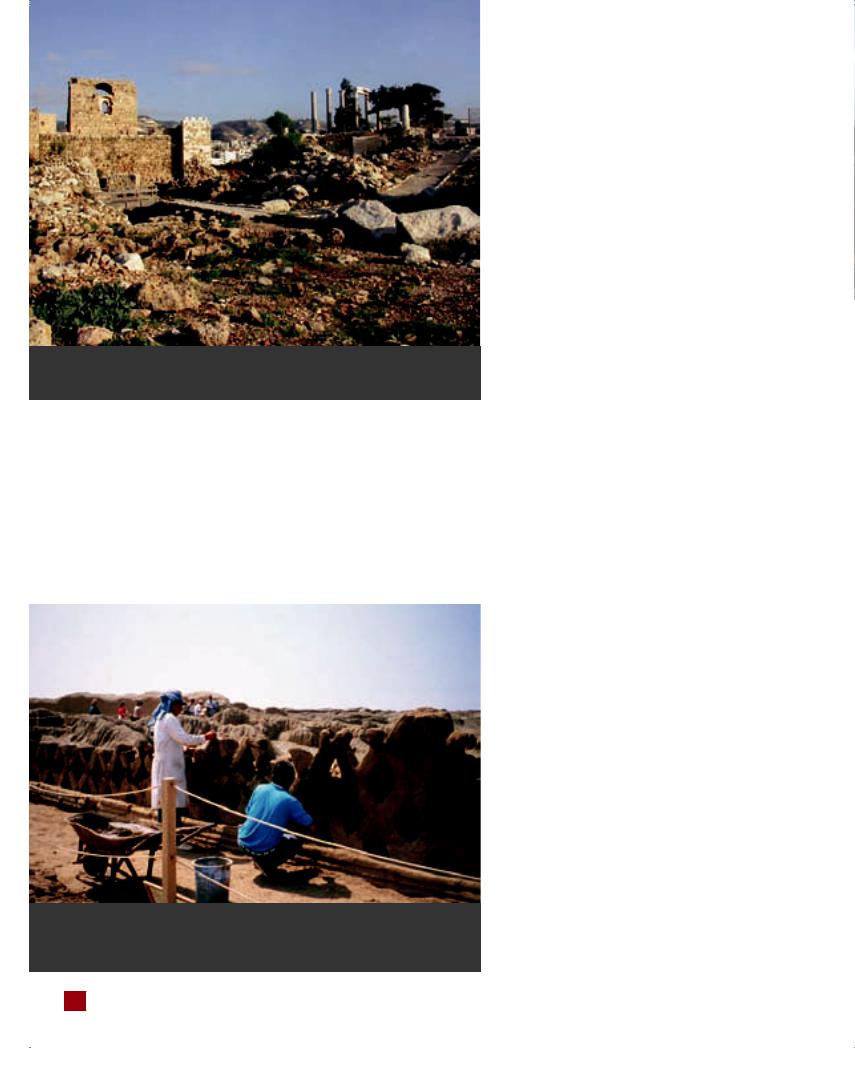
Figure 6 42
The archaeological site of Byblos, Lebanon
While ICCROM’s ‘classic’ International Architectural Conservation Course had been discontinued in Rome, its logic and philosophies had been carried over to other programmes that continued to flourish at ICCROM and in collaboration with partners in other regions. Indeed, responding to the many needs and demands, the ARC course expanded in scope beyond its original educational objectives, and diversified into different activities, projects or programmes focussed on particular materials or particular regions
Figure 6 43
The courses in the Preservation of the Earthen Architectural Heritage (PAT96) in Latin America, conservation work at Chan Chan, Peru
(or a combination of the two). Examples have already been given: the ‘Wood Course’ (Norway), the ‘Stone Course’ (UNESCO, Venice), the Architectural Conservation course in Tunis, the ITARC courses in Rome, the Modern Architecture Course (MARC, Finland), the GAIA and TERRA Projects (including four international and two Pan-American PAT courses), the NAMEC and Sites Programmes, the Africa 2009 Programme and the ITUC Programme. In 2002, Stanley-Price in an ICCROM discussion paper noted that there was evidently a continuing need for advanced professional education in architectural conservation, and new needs could be addressed in collaboration with partners either in Rome or in the regions concerned.312
The 10-year ITUC Programme (Integrated Territorial and Urban Conservation), which had been launched in 1995, continued to develop and mature based on the original scientific and philosophical basis until its conclusion in 2005, co-ordinated by the Heritage Settlements Unit of ICCROM under Herb Stovel. The efforts in this period were oriented particularly toward consolidating training curricula and supporting materials, to increasing access to these materials, and to strengthening training infrastructures at regional levels for long-term sustainability. The principal idea was that there should be an international team of professionals forming the core of the programme, which would include an international training programme every two years. The first course focused on cultural landscapes and took place in Rome (November-December 2002), involving partners in Brazil, USA, and Sweden and the UNESCO World Heritage Centre. The essence of the course concerned what was a cultural landscape and how should it be sustainably managed so as to keep it alive. “Conventional heritage approaches focus on the state of conservation of particular heritage features and elements. A cultural landscape approach focuses on the key processes that have shaped, and continue to shape, the character of the landscape. Cultural landscapes are not saved by conventional conservation tools, such as ‘development control’, but by a recognition of the forces that govern the dynamics of change - agricultural policy, for example, often set by government without any regard for its impact on the landscape.”313 The problem often was to identify the appropriate limits of change without losing the character and qualities of the landscape.
An International Course on Integrated Territorial and Urban Conservation was organized, along with an International Expert Seminar, at ICCROM in Rome in April-June 2003. The programme benefited from a long-term collaboration with CECI (Centro
 134
134 ICCROM and the Conservation of Cultural Heritage. A history of the Organization’s first 50 years, 1959-2009
ICCROM and the Conservation of Cultural Heritage. A history of the Organization’s first 50 years, 1959-2009
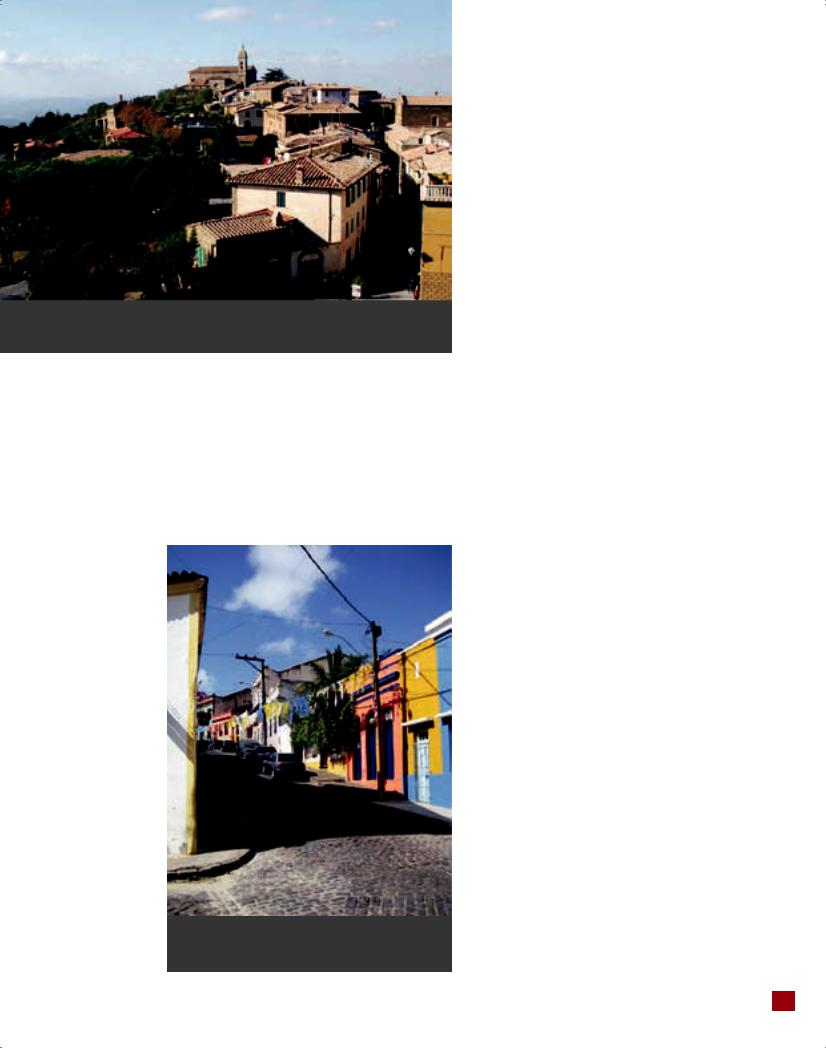
Figure 6-44
Val d’Orcia cultural landscapes in Tuscany, Italy
de Estudos Avançados da Conservação Integrada), created by Silvio Mendes Zancheti at the Federal University of Pernambuco in Recife, Brazil and was developed by a small in-house team, including Jokilehto, Joseph King and Zancheti. It organized meetings of the core group in Rome, Canada and Brazil, leading to regional programme activities in Brazil (in agreement with CECI), the Baltic States (through the Academy of Cultural Heritage in
Figure 6-45
The World Heritage town of Olinda, Brazil
Lithuania) and South-East Asia. The most active of these was the Brazilian initiative, which developed into a strong programme activity addressing the entire Latin America, introducing innovative teaching tools such as Internet-based distance learning combined with a field project. One of the field projects was the preparation of a Management Plan for Olinda, a World Heritage City, considered the first in Latin American to have such a plan. In May 2003 the third International Seminar for Integrated Urban Conservation was organized jointly with CECI and the School of Architecture of the Federal University of Bahia, in Salvador de Bahia. The theme of the seminar was Conservation Management of Historic Cities, and it was attended by some 200 participants. The ITUC methodology was applied to a new programme on Living Heritage Sites Conservation in South-East Asia, launched in a joint meeting with SPAFA in Bangkok in late 2003 and further developed into a series of meetings and seminars in the Mekong River region (2004).
Technical services
On January 1 2001 the Director-General established a new Office of Communication and Information (OCI) at ICCROM. “The aim was to bring together a number of functions that had previously been separated, in the belief that they would be more effective if they were centralized and integrated. These functions include: promotion of ICCROM, fundraising, publications, and the acquisition and diffusion of information.”314
The Library continued to expand. From November 2003 to October 2005, it registered 4465 new publications, including books, journal issues, leaflets and reports, bringing the holdings to 76 552. The Library continued to assist daily users in its reading-room and to provide assistance to remote users through interlibrary loan, email references and document delivery. In 2005 the bibliographical and conference database stood at 90 400 entries, higher than the number of actual holdings due to multiple articles in many collective works and conference paper publications. ICCROM entered into an agreement with AATA Online, managed by the Getty Conservation Institute (GCI) in collaboration with IIC, to send to AATA abstracts of current conservation literature received by the Library, which increased the visibility of ICCROM’s Library holdings.
The ICCROM Archive continued systematically to store inactive files of all ICCROM Departments and Activities, including current ICCROM Mission Reports. The newly-appointed Archivist re-arranged the archive, providing an improved description for inactive files of the Office of the Director-General
6 New global challenges (1988-2005)  135
135

Figure 6 46
ICCROM Library with the Librarian, Paul Arenson (left)
and using an archival database software designed by the ICA (International Council of Archives) that was compliant with ISAD(G) description standards. The Archive had already received the donation of the slide collection of Jukka Jokilehto, to which were added three further collections by retiring staff members (Herb Stovel, Alejandro Alva and Rodolfo Luján). The image collections are stored in climate-controlled conditions so as to reduce ageing processes and slides are gradually being scanned for digital archiving and partial access via the Internet.
In 2002 ICCROM established a Technical Assistance Service, with policies similar to those of the former Technical Assistance Programme (TAP) which had been discontinued in 1995. This Service was designed to provide, free-of-charge, conservation literature, ICCROM publications and photocopies, minor equipment and other supplies. The Service was available only to Member States of ICCROM. A new half-time post was created for administering this Service and for assistance with Library accessions. Response to requests followed the criteria set out in the Policy and Procedures for the Technical Assistance Service document, completed in early 2002.
Reflection on the period 2000-2005
The mandate of Nicholas Stanley-Price came after a long and hectic re-structuring process under his predecessor, which had left the staff rather exhausted. Stanley-Price was able to build on these foundations and review the strategic orientations in relation to the new demands and challenges. This period could be characterized as intellectual and perhaps low-profile, compared to the previous managerial period, but it was also a period that aimed at perfection and high
quality. Stanley-Price not only based his policies on previous achievements; he also refined these, asking for the highest quality in project management and in administration. Indeed, while the previous period had already carried out a revision of ICCROM’s administrative structure, this was still further refined by Nicholas Stanley-Price. An important part of this process was the re-introduction of training programmes held in ICCROM’s premises, which had indeed become a perfect venue with its excellent library and the didactic laboratory. He strengthened ICCROM’s research function, inviting research fellows and offering internships. He also gave much importance to excellence in publications, introducing for example the series of ICCROM Conservation Studies.
 136
136 ICCROM and the Conservation of Cultural Heritage. A history of the Organization’s first 50 years, 1959-2009
ICCROM and the Conservation of Cultural Heritage. A history of the Organization’s first 50 years, 1959-2009

7
Working towards the future
International context
In 2005 the United Nations General Assembly adopted the resolution of the 2005 World Summit315 that summarises some of the principal aims for implementing the UN Millennium Development Goals of 2000. The document paints a broad world canvas extending from development and respect of human rights to diffusing the culture of peace. It acknowledges the diversity of the world and recognizes that all cultures and civilizations contribute to the enrichment of humankind. We can see that UNESCO, ICCROM and other international heritage organizations also work in this same context. The World Heritage Convention has by now reached a certain maturity, and is recognized as a top international instrument in promoting awareness and safeguarding of heritage worldwide. The international network built around the Convention, including the Advisory Bodies ICCROM, ICOMOS and IUCN, have refined the regular monitoring and management of the cultural and natural heritage sites on the World Heritage List that had reached 890 by 2009. On 20 April 2006 the Convention for the Safeguarding of Intangible Cultural Heritage (2003) entered into force after thirty States had ratified it on or before 20 January 2006. This Convention complements the World Heritage Convention, and gives a concrete evidence of the extension and astounding diversification of the concept of heritage. In 2003 the
former Chairman of ICCROM’s General Assembly, Abdelaziz Daoulatli, questioned the relationship between the 1972 and 2003 Conventions, stating that “both types of heritage constitute an indivisible whole, tangible heritage being in fact the material expression of intangible heritage. Under these conditions, is it not more prudent and judicious to synergize both components of cultural heritage, unifying the methods and means used to conserve them, and hence manage to give an even more humanistic meaning to the universal, putting greater emphasis on the notion of cultural diversity.”316 When the 1972 Convention reaches its 40th anniversary in 2012, the emerging challenges will include the integration of the different disciplines and the establishment of a dialogue across professional and cultural boundaries. Indeed, living heritage and com- munity-based operations have emerged as priorities, particularly in the management and sustainable development of cultural landscapes.
In 2008 the 15th Triennial Conference in New Delhi of ICOM-CC (the International Committee for Conservation of ICOM), focused on Diversity in Heritage Conservation: tradition, innovation and participation. In 2011 the 16th Triennial Conference in Lisbon is planned to discuss Cultural Heritage / Cultural Identity: the role of conservation. It is clear how far the themes have evolved from past decades when the main attention was on material preservation. The diversity of heritage is also reflected in
7 Working towards the future 137

the thematic range of the international scientific committees of ICOMOS, which include shared built heritage, the heritage of the Pacific Islands, the 20th century heritage, fortifications and military heritage, underwater cultural heritage, historic towns and villages, cultural landscapes and cultural routes. The international charters adopted by the General Assembly of ICOMOS include the Charter on Cultural Routes and the Charter on the Interpretation and Presentation of Cultural Heritage Sites, both produced in 2008. In the first decade of the 21st century, risk preparedness and post-conflict recovery tend to remain constants which found their place also in ICCROM’s Strategic Directions. The extension of the definition of the notion of heritage is reflected in the increasing concern for the context beyond the actual ‘heritage site’. Indeed, the Xi’an Declaration on the Conservation of the Setting of Heritage Structures, Sites and Areas adopted by the ICOMOS General Assembly in 2005 and the Vienna Memorandum, resulting from an international conference in Vienna in 2005, both indicate the aim toward more comprehensive and more integrated planning and management of the built and natural environment. The Vienna Memorandum, in particular, has launched the notion of Historic Urban Landscape (HUL) which has since been recognized by UNESCO as a reference for a new international recommendation.
Figure 7 1
CollAsia programme; traditional painting in Laos
One of the key persons in the definition of modern conservation theory was certainly Cesare Brandi, a distinguished Italian art historian and critic and the founding Director of the Istituto Centrale del Restauro (from 2007 the Istituto Superiore per la Conservazione ed il Restauro). The centenary of his birth in 1906 coincided with the arrival of a new Director-General at ICCROM, and was accompanied by a series of events and conferences organized across the world to re-assess Brandi and his work. As part of the initiatives, the Associazione Amici di Cesare Brandi promoted the translation and publication of his key texts, in particular his Theory of Restoration, into the principal languages of the world, including Japanese, Chinese and Persian in addition to several European languages, such as Russian and Portuguese. The theory of Brandi was taken as a synthetic expression and basic reference for the development of conservation policies in the second half of the 20th century. It is obvious that the developments over the past fifty years have added many ingredients to international doctrine. This does not mean that what has been achieved by past generations would lose its meaning. On the contrary, it constitutes part of the modern conservation culture in today’s world, an element to be observed in the processes of learning and cultural sustainable development of the manyfaceted heritage of humankind.
The decade of the 2000s saw a global explosion in prices particularly in commodities and housing. In 2008, the prices rose so high as to cause serious economic damage; oil prices reached US $147.30 a barrel in July 2008. With the increasingly free economy and housing bubble, some economists started predicting a possible recession, which came first in USA, followed by Japan and Europe. The recession caused a collapse of the housing market, banking systems, and automobile industry. Signs of recovery were seen in 2010, even though the Euro was still in serious difficulty due to high deficits in some EU member countries. The consequences of the recession were felt particularly in intergovernmental organizations, such as ICCROM, which had to take strong measures and revise the basis for its Programme and Budget.
Verification of strategies and programmes: the directorship of Mounir Bouchenaki
Dr. Mounir Bouchenaki was appointed DirectorGeneral of ICCROM in November 2005, taking up his post from 1 March 2006 after retirement from UNESCO. He was born in Algeria, and had a Ph.D. in archaeology and ancient history from the Arts Faculty of Aix-en-Provence (France). From 1975 to
 138
138 ICCROM and the Conservation of Cultural Heritage. A history of the Organization’s first 50 years, 1959-2009
ICCROM and the Conservation of Cultural Heritage. A history of the Organization’s first 50 years, 1959-2009

Figure 7 2
Mounir Bouchenaki, Director-General of ICCROM from 2006
1981 he served as Deputy Director, then Director of Fine Arts, Monuments and Sites at the Ministry of Information and Culture in Algiers. He joined the Division of Cultural Heritage of UNESCO in 1982 as a programme specialist, becoming Director of the Division in 1992. From February 1999, he served as acting Director of the World Heritage Centre, and was appointed Assistant Director-General for Culture on l November 2000. His publications have focused especially on archaeological research and protection of the cultural heritage. Bouchenaki had already a long collaboration with ICCROM in his positions at UNESCO, and even earlier, when he worked in Algeria responsible for archaeological heritage and rock art.
The Programme and Budget for 2006-07 that had been prepared by his predecessor, and approved by the General Assembly in November 2005, had a strong element of continuity in its main components. The Strategic Directions adopted by the General Assembly in 2001 had been reviewed and revised in the light of changing needs, and had taken account of the recommendations of ICCROM’s statutory bodies, the formal evaluation reports, mission reports, publications, professional staff meetings, and contacts with the network of partner institutions. The introduction drew attention to the changes that were taking place in the world, observing that even if there had never been comparable attention to cultural heritage by Governments and the media (especially due to increasing visibility of the World Heritage), there tended to be “a trend in conservation towards declining public funding, de-centralization of responsibilities for culture, and outsourcing of
conservation work needs to be addressed.”317 Despite the high quality of individual work in the conservation field, there was a reduction in the employment of professionally qualified personnel, resulting in weakening of institutional memory and lack of proper monitoring of the state of conservation of heritage. Budgetary cuts had also affected publically financed conservation teaching programmes. At the same time, the opportunities for training in conservation in relatively expensive private programmes had increased. However, the demand for a chance to participate in an ICCROM course was higher than ever, on issues such as conservation of materials and documentation.
“As an IGO, ICCROM serves first and foremost its Member States. It therefore should support governmental institutions as a priority (as it does in its responses to official requests and in its proactive programmes). Even in those many states where conservation work tends to be contracted out, support is needed for professional state employees who can guarantee institutional memory and continuity, who can direct conservation projects, and who can ensure regular maintenance and monitoring of the cultural heritage. ICCROM’s programme, in addressing the needs of Member States, must therefore continue to strike an appropriate balance in promoting technical and managerial skills. In recent years, the balance in its education work has shifted towards the latter, on the reasonable argument that the regular courses held at ICCROM in the 1970s to late 1990s had trained a core group of
Figure 7 3
ICCROM’s celebration of 50 years of activity
7 Working towards the future  139
139
